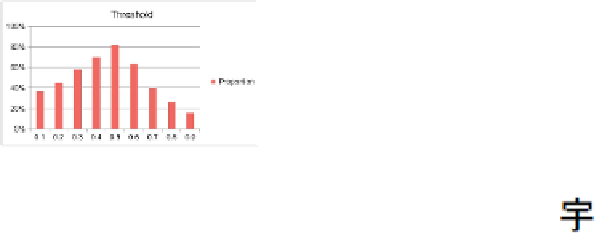Image Processing Reference
In-Depth Information
(2)
where
D
(
i
,
j
) and
D
(
p
,
q
) represent the ADR of the arcs (
i
,
j
) and (
p
,
q
); Digraph (Nodei)
i
) and
InvD (Node
p
) indicate the number of direct links for vertex
i
and inverted links for vertex
p
,
respectively.
T
is the threshold value of ADR determined by 10 runs of experiments with the
value of 0.1-0.9 assigned to 500 documents and the result was verified by five subject special-
documents as a testing data set showed that 0.4 outperforms the others, while this study used
five times of previous samples reveal that the accuracy rate of 0.5 reaching 82% is the best cut
frequency theory, it infers that the significance of the concatenation will be proportional to its
frequency. Since this study was to identify anecodotes from single documents, we set a min-
imum degree as 2.
FIGURE 8
Thresholds scatter diagram of ADR.
Figure 9
shows a digraph with ADR and degree, the arc ( , ) (Yu, Chang) with the
expression [1, 2] indicating that the intensity is 1 and the degree is 2, therefore it will be con-
only on directed links but failed in detecting significant concatenations from inverted links.
For example, the LC “[
]” (Scandal) with the value [0.33, 2] of the direct link (
,
) will not be concatenated if we don't consider its inverted link (
,
) with the value [1,2]
FIGURE 9
Digraph with concatenate vertices.
3.2.3 Step 3: Run iteration
The above steps will be iterated until no concatenation can be found, and this iteration
process will generate a series of short and long LCs as anecdotes. A long LC is believed to









Search WWH ::

Custom Search